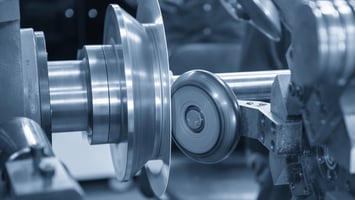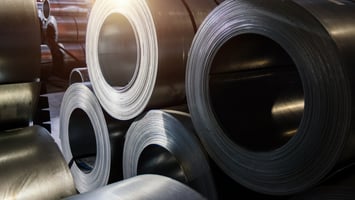Metal spinning is a common metallurgy process that turns a blank workpiece into an axially...
Kryton Metals Blog
The Science Behind Spinning Metal

Manual and CNC lathes are essential equipment when it comes to machine shops or metal fabrication facilities. In most cases, their function is to remove material and produce axially symmetrical, or round, parts using dimensions and tolerances from a drawing.
However, there is another method for achieving round parts without removing or stripping away any metal: metal spinning. Sometimes referred to as spin forming, metal spinning deforms a flat sheet of metal over a pre-shaped mandrel without cutting or heating the material. And with steel costs on the rise, it makes sense not to waste any of it by turning it into chips.
Metal spinning works with any ductile metals, including carbon steel, aluminum, stainless steel, copper, and even titanium. While the process was once used exclusively for prototyping and low-quantity runs, CNC technology has made it possible to manufacture parts in high quantities while keeping costs low.
A Step-By-Step Guide to Metal Spinning
Since metal spinning is a unique process that might not be well-known throughout the metal fabrication community, the following example may help:
- A mandrel, which is machined in the shape of the finished part, is attached to the lathe.
- The metal blank is then attached to the mandrel or held in place by the tailstock.
- The mandrel and plate rotate at high speed as the forming tool presses the plate to fit the shape of the mandrel.
- If necessary, the leftover material at the end is trimmed, and the part is complete.
This process can be used to produce a wide variety of axially symmetrical parts in different shapes and sizes.
What Are Some of the Advantages of Metal Spinning?
Metal spinning offers significant benefits, not the least of which is its ease of use. Because it is a cold-working process, which requires no heating of the metal as it is reshaped, it is much simpler and safer than other processes.
Another advantage occurs as the metal is deformed. Metal spinning tends to compress the material, often making the spun metal stronger than it was before. As the metal is exposed to the rotational force of the lathe, the compression increases its tensile strength and provides a high-performance finished product.
Other benefits include:
- Lower tooling costs than other types of metal shaping.
- Ideal for either prototyping or production parts.
- Single-piece, seamless metal parts are typically stronger and can tolerate a higher pressure.
- Multiple steps in the forming process can be completed at the same time.
- Shorter lead times.
- Less material wasted.
What Are the Typical Industrial Uses for Metal Spinning?
Metal spinning is a versatile and cost-effective method that has numerous commercial and industrial applications. Some of the typical uses for metal spinning include:
Heavy industrial components for oil, agricultural, and land vehicles
- Parts for oil drilling equipment
- Components for livestock-feeding
- Parts for earthmoving equipment
Commercial foodservice equipment
- Stainless steel cooking kettles
- Smoker housings
- Housings for high-pressure cookers
Commercial lighting
- Light reflectors made of stainless steel, aluminum, brass, and copper
Sanitation
- Flanged steel rings for street sweepers
- Steel ring housings for sewer cleaning equipment
Filtration industry
- Air filtration cartridges
- Sleeves and rings
Medical
- Medical imaging housings
- Components in laboratory equipment
HVAC
- Parts that withstand extreme conditions in commercial HVAC applications
Automotive
- Custom steel wheel rims in various sizes and designs that withstand rugged terrains
Miscellaneous
- Aerospace and defense components
- Gas cylinders and pressure vessels
- Musical instruments
Are There Different Types of Metal Spinning?
Metal Spinning Lathes
When it comes to sheet metal spinning, metal spinning lathes typically fall into three broad categories: manual, power-assisted, and automatic.
Manual spinning lathes can generally handle a wide range of flat blanks from 1.0″ up to 72″ in diameter. A skilled human operator uses a forming tool to apply pressure to a blank sheet of metal. Then, the operator shapes the metal into a desired form of shape using their experience. Although they can handle a wide range of blanks, manual spinning lathes may not be as efficient or precise as power-assisted or automatic spinning lathes.
Power-assisted spinning is a manual process augmented by hydraulic cylinders. It works well for forming stronger metals (stainless steel and alloys) when human power is insufficient to shape the piece. An experienced operator uses a manual spinning lathe along with a power-assisted feature to shape the metal. The operator applies pressure through the forming tool, while the hydraulic cylinders support the metal and apply additional force to deform the metal. The benefit to using power-assisted spinning is that it shapes larger and stronger metals.
Automatic spinning uses CNC to automate the spinning process. The lathe is controlled by a computer program, rather than a human operator, that directs the movement of the forming tool and the rotation of the metal workpiece. This method can reduce the need for skilled operators, making the production process more efficient and cost-effective. This way is also useful for precision high-volume parts that demand consistency.
Metal Spinning Operations
There are also four operations associated with metal spinning: conventional, shear, preforms, and edge treatment.
Conventional spinning uses metal rotating at high speeds as a tool is applied to shape and form it. The metal is typically formed in a series of passes where each pass stretches and thins the material, which gradually forms into the desired shape. This process is beneficial for creating simple and symmetrical shapes such as bowls, cups, domes, and other similar forms.
Shear spinning is often used to produce conical and cylindrical shapes accurately. Unlike conventional spinning, the finished part is formed in one pass. During this process, a special spinning tool moves quickly over the surface of a rotating metal blank, exerting force on it until the desired shape is achieved.
Since the spinning tool is specifically designed to exert pressure only in certain areas, it will produce the desired shape without thinning or stretching the metal excessively, which is why shear metal spinning is a very precise and efficient method of producing high-quality metal parts.
Preforms are shaped metal discs or flat blanks that are spun or drawn from a variety of materials, including sheet metal, brass, aluminum, or copper, and are often created to precise dimensions required for the final spun part. By using preforms, the metal spinning process can be made more efficient, as they help to reduce material waste and allow for consistent, repeatable results.
Edge treatment refers to the process of finishing the edges of the spun piece. Usually, the part is trimmed on a lathe to create a straight edge, but in some cases, the part may be removed and finished on another machine as a secondary operation. This process helps unsure that the part meets the desired specifications and is safe to handle since the goal of edge treatment is to remove any excess materials (burrs or sharp edges) and create a smooth, even edge.
Learn more about metal spinning and all that it has to offer at KRYTON’s blog page.



